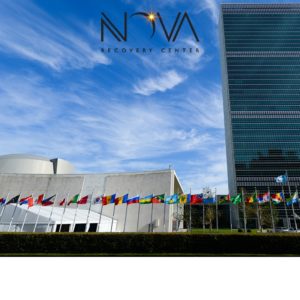 For the first time since 1998, The United Nations General Assembly will gather in New York for a special session to tackle the “World Drug Epidemic”. A brief history lesson brings us to 1971, President Richard Nixon declared the war on drugs. He proclaimed, “America’s public enemy number one in the United States is drug abuse. In order to fight and defeat this enemy, it is necessary to wage a new, all-out offensive war. Since then, governments have taken a punitive approach to fight the war on drugs. Our approach to the epidemic is that, the drugs themselves are the problem. We have punished manufacturers, locked up traffickers and suppliers and treated the drug user as a criminal. During this process our police departments have expanded and prison systems ballooned. With all our efforts, the problem is still here today.
For the first time since 1998, The United Nations General Assembly will gather in New York for a special session to tackle the “World Drug Epidemic”. A brief history lesson brings us to 1971, President Richard Nixon declared the war on drugs. He proclaimed, “America’s public enemy number one in the United States is drug abuse. In order to fight and defeat this enemy, it is necessary to wage a new, all-out offensive war. Since then, governments have taken a punitive approach to fight the war on drugs. Our approach to the epidemic is that, the drugs themselves are the problem. We have punished manufacturers, locked up traffickers and suppliers and treated the drug user as a criminal. During this process our police departments have expanded and prison systems ballooned. With all our efforts, the problem is still here today.Overdose deaths from opioids drugs like heroin oxycodone and hydrocodone continue to be the leading cause of unintentional death for Americans, rising 14% from 2013 to 2014. Every 19 minutes someone dies from an opioid overdose.
But President Obama has started to shift toward a more humane, public health approach to drug policy and our justice system.
For the first time since the 1980s, the federal government would spend more money on treatment and research plans than on law enforcement under President Obamas new proposed budget that was released earlier this year. The President has made clear that addressing this epidemic is a priority for his Administration. These actions build on the President’s proposal for $1.1 billion in new funding to help every American with an opioid use disorder who wants treatment get the help they need.
Expanding Treatment
Currently, prescribers are limited by the law to prescribing buprenorphine to only 100 patients per doctor. President Obama is now increasing that number to 200 per doctor. Last year, states and private sector groups proposed to double the number of buprenorphine prescribing physicians over the next three years from 30,000 to almost 100,000. This will expand access to treatment in rural areas where treatment is limited.
- On top of expanding access to MAT, the White House announced other initiatives:
- Providing an additional $11 million to increase access to naloxone, the opioid overdose reversal drug.
- Establishing a Mental Health and Substance Use Disorder Parity Task Force.
- Ensuring that mental health and substance use benefits are offered as medical and surgical benefits are for those enrolled in Medicaid and the Children’s Health Insurance Program.
- A $7 million initiative by the Department of Justice toward policing and investigating heroin distribution.
- Guidance from the Department of Health and Human Services for federally funded needle exchange programs.
The Centers for Disease Control and Prevention (CDC) issued New Opioid Prescribing Guidelines. These guidelines state that opioids should not be the first consideration for chronic pain, and that the prescriber should first consider non-opioid pain relievers or non-drug alternatives such as exercise, meditation, and cognitive-behavioral therapy.
No comments:
Post a Comment